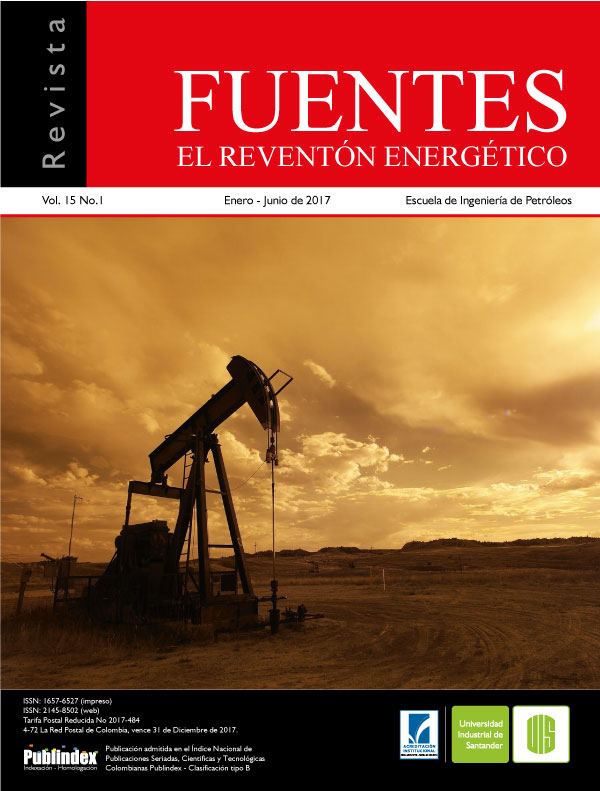Optimization of rate of penetration by vibration analysis, case study Ecuador
Published 2017-06-01
How to Cite
Abstract
Exposure to vibrations in the oil well construction is an inherent phenomenon of drilling operation, the increasingly complex geometries of the wells, the hardness of the formations crossed are factors that cause unfavorable conditions and promote a failure of the drilling tools. The study outlines the optimization process carried out to drill Napo Formation (Cuenca Oriente) in 12 ¼ “ section using vibration sensors to record the drilling dynamics; the analysis was performed in three directional oil wells, the correct interpretation of the records and the implementation of the recommendations that resulted from the well-to-well analysis allowed to make changes in the design of the BHA and to establish parameters of drilling, which result in lower levels of vibration and therefore in better performances .
Keywords: Drilling optimization, Drilling problems, Drilling vibrations.
Downloads
References
- Ayala, D., Torres, F., Valencia, R. y Loaiza, M. (2016). Impacto del Tiempo no Productivo en Operaciones de Perforación y Análisis de los datos Mediante la Prueba de Chicuadrado. Fuentes El Reventón Energético, 11.
- Baldock. J. (1982). Geology of Ecuador. (pág. 20). Quito: Dirección General de Geología y Minas.
- Bady. P., Rivadeneira. M. y Barragán. R. (2004). La Cuenca Oriente: Geología y Petróleo. Quito: Editores Científicos.
- Betson, H. y Smith, H. (1956). Rock-Bit Desing, Selection and Evaluation. API 56-288, 35.
- Brelt, J., Warren, T. yBehr, S. (1990). Bit Whirl – A new Theory of PDC Bit Failure. SPE 19571-PA, 275.
- Cassanelli, J., Franco, M., Pérez, L., Pinheiro, C. y Frenfel, M. (2008). Dynamic Simulation Solving Vibration/Stick-Slip Issues Achieves Record ROP, Pagoreni Field. Perú. Lima.
- Centale, P., Chala, V., Meehan, R., Páez, L., Partin, U., Segal, S., Wu, S., Garret, I., Teggart, B., Tetley, B. (2011). El diseño de las barrenas: Desde arriba hasta abajo. Sugar Land: Oilfield Review, 17.
- DATALOG. (2001). Datalog Manual de Operaciones en el Pozo (Tercera ed.).
- Dykstra, M., Neubert, M., Hanson, J. y Meiners, M. (Marzo de 2001). Improving Drilling Performance by Applying Advanced Dynamics Models. SPE/IADC 67697-MS, 18.
- Garret. I., Teggart. B. y Tetley. (2010). FEA Modeling system Delivers High-Angle Well Bore through Hard Formations. E&P 83, no. 9.
- García, R. (2008). Estudio del Rendimiento de la broca HCM605Z para la sección de 12 1/4” diseñada para la perforación de pozos horizontales en el campo Tarapoha. Guayaquil: Escuela Politécnica del Litoral.
- Jaillard, E., Benqston, P., Ordoñez, M., Vaca. W., Dhondt, A., Suárez, J., Toro, J. (2007). Sedimentary record of terminal Cretaceous accretions in Ecuador. Journal of South America Earth Sciences.
- Korin, I., Morris, W., Gómez, M., Achem, H., Rodriguez, J. y Oroña, J. (2015). Desarrollo e Implementación de un Sensor de Vibraciones. San Antonio.
- Navarro, E. y Suárez R. (2004). Vibraciones en una Sarta de Perforación: Problemas de Control. (pág. 6). Mexico: CONACYT 35989-A.
- National Oilwell Varco. (2007). A Guide to Drilling Vibration. Houston.
- Salazar, F. y Sánchez, H. (1989). Evaluación de las Arcillas en la Formación Napo, Areniscas «U» y «T» en la Cuenca Oriente. (pág. 158). Quito: Universidad Central del Ecuador.
- Sananikone, P., Kamoshima, O. y White, D. (1992). A Field Method for Controlling Drillstring Torsional Vibrations. Proceedings of the IADC/ SPE Drilling Conference (págs. 443-452). IADC/SPE 23891.
- Schlumberger. (s.f.). Sensores y Optimización de la Perforación.(pág. 16).
- Williamson, J. y Lumbiski, A. (1986). Predicting Bottom hole Assembly Performance. IADC/ SPE 14764-PA, 13.
- Xianping, S., Páez, J., Partin, U. y Agrinhorti, M. (2010). Decoupling Stick-Slip and Whirl to Achieve Breakthrough in Drilling Performance. IADC/SPE 128767-MS, 13.
